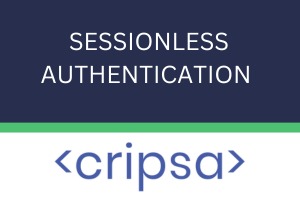Sessionless Authentication
Date Created: 03 Nov 2023Share:
The digital realm is evolving at an unprecedented pace, with cybersecurity and user experience at the forefront of concern.

Sessionless Authentication: A Paradigm Shift in User Security and Experience
The digital realm is evolving at an unprecedented pace, with cybersecurity and user experience at the forefront of concern. In this landscape, sessionless authentication is emerging as a transformative approach. Unlike traditional session-based authentication, sessionless authentication operates without storing user data on servers. This blog explores the rise of sessionless authentication, its significance, and the profound impact it has on both user security and experience.
Understanding Sessionless Authentication
Sessionless
authentication is an innovative method for verifying user identities,
eliminating the need for persistent session data storage. Traditional
authentication methods involve storing user data on the server for the duration
of a users session, which can lead to security vulnerabilities. In contrast,
sessionless authentication relies on stateless protocols and tokens to verify
user identities, without retaining any user data on the server. Each
authentication request generates a unique token, providing secure and temporary
authorization for a specific action, after which the token becomes invalid.
Advantages of Sessionless Authentication
Sessionless
authentication offers numerous advantages over traditional session-based
methods:
Enhanced Security:
Sessionless
authentication minimizes the risk of session hijacking and data breaches since
user data is not stored on the server, reducing exposure to security threats.
Improved Privacy:
User
privacy is better preserved as no persistent personal data is stored. Once the
action is completed, the temporary token becomes invalid, ensuring that no user
information lingers on the server.
Efficiency and Speed:
Sessionless
authentication is faster and more efficient, as it eliminates the need for
constant server-side data management. Users can complete actions swiftly.
Scalability:
Stateless tokens are easier to scale and manage, accommodating a growing number of users without compromising performance.
Practical Implementation
Sessionless
authentication is already being employed in various applications and services,
with JSON Web Tokens (JWT) being a notable example. JWT is a compact, secure
means of representing claims transmitted between parties, enabling efficient
authentication without storing session data on the server.
Heres how sessionless authentication works in practice:
User Authentication:
When
a user logs in or accesses a secure resource, they are authenticated by the
application server.
Token Generation:
Instead
of creating a session, the server generates a unique token (JWT) containing
user claims, signed with a secret key.
Token Transmission:
The
token is sent to the users device and stored locally, often as an HTTP header,
a cookie, or within the URL.
Access to Resources:
Users
present the token for each request to access secured resources. The server
validates the tokens authenticity and grants access if the token is valid.
Token Expiration:
Tokens
can be set to expire after a specific duration, providing an additional layer
of security. Users re-authenticate to obtain a new token when it expires.
Logout and Token Invalidation:
Users can log out or request token invalidation, ensuring that even if a token is compromised, it can no longer be used to access resources.
Realizing the Benefits
Sessionless authentication offers a range of benefits:
Enhanced User Experience:
Sessionless
authentication simplifies the user experience, eliminating the need for
repeated credential entry, making the process smoother and more convenient.
Stronger Security:
Eliminating
the need for session data storage reduces the risk of data breaches and session
hijacking. Short-lived tokens enhance security.
Global Scalability:
Stateless
tokens can be scaled easily, ensuring consistent performance regardless of user
volume.
Reduced Server Load:
The
absence of session data on servers lightens the load on server resources,
improving application performance.
Privacy Protection:
User privacy is preserved as there is no long-term storage of user data. Even if a token is compromised, the exposure is limited to a short timeframe.
Implementing Sessionless Authentication
Effective implementation of sessionless authentication involves several key steps:
Token Management:
Select
a secure token format, such as JWT, and implement proper token management,
including token expiration times and refresh mechanisms.
Authentication Provider:
Choose
a robust authentication provider that supports sessionless authentication to
ensure a secure and reliable authentication process.
User Consent:
Ensure
transparency by informing users about the use of sessionless authentication and
obtaining their consent.
Token Validation:
Implement
strong token validation mechanisms to ensure that only legitimate and unaltered
tokens are accepted.
Revocation Mechanisms:
Provide users with options to revoke tokens or log out, giving them control over their security.
The Future of Sessionless Authentication
The
adoption of sessionless authentication is on the rise, with further innovation
expected. Some potential developments include:
Biometric Authentication:
Integration
of biometric authentication methods, such as fingerprint and facial
recognition, to enhance security and user convenience.
AI-Powered Token Validation:
Use
of artificial intelligence to monitor and detect suspicious token usage in
real-time, strengthening security.
Blockchain-Based Authentication:
Integration
of blockchain technology for tamper-proof authentication records, increasing
trust and transparency.
Decentralized Identity Solutions:
Emergence of decentralized identity solutions, providing users more control over their digital identities.
Sessionless
authentication is revolutionizing user security and experience in the digital
age. By eliminating the need for session data storage, it provides enhanced
security, improved user privacy, and a more efficient experience. As
sessionless authentication gains traction in various applications and services,
its potential for further innovation positions it as a pivotal player in the
future of online security and user authentication. Embracing these changes is
essential for organizations and developers looking to provide a secure and
user-friendly experience in the ever-evolving digital landscape.

